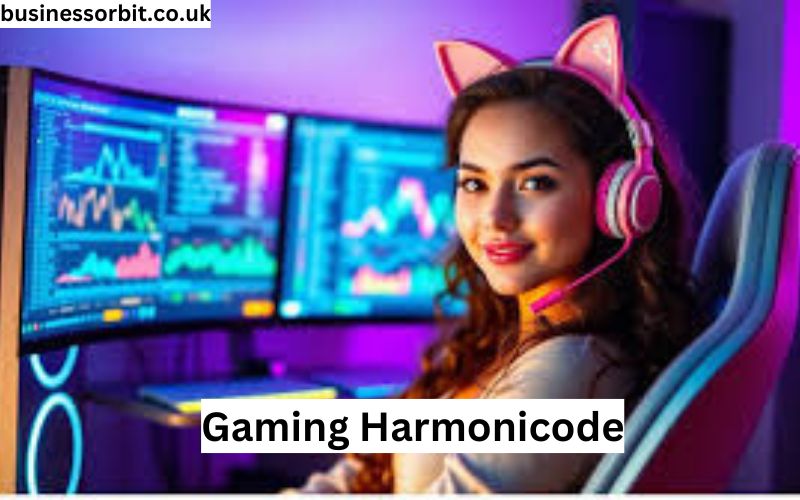The world of gaming has evolved at a rapid pace in recent decades. From simple pixelated 2D adventures to vast, immersive 3D open-world games, the evolution of gaming has brought about an explosion of creativity, technology, and culture. Alongside this, the integration of music, sound, and rhythm into gaming has also transformed into a complex art form.
In recent years, a new phenomenon has emerged: Harmonicode, a genre of gaming that fuses harmonic elements of music and code to create interactive and innovative gaming experiences.
This article explores the concept of Harmonicode, its origins, its impact on gaming and music, its technical aspects, and how this genre might shape the future of the entertainment industry.
What is Harmonicode?
Harmonicode can be understood as the intersection of musical composition and programming, where the fundamental principles of music theory are integrated with the logic of game development. At its core, it is an exploration of how sound and harmony can be used to influence gameplay, storytelling, and overall user experience.
Harmonicode games typically involve elements where music and gameplay mechanics are intertwined, allowing players to interact with music in a way that directly influences their actions within the game.
Origins of Harmonicode
While gaming and music have always been connected—particularly through soundtracks and in-game music—the idea of combining music theory and gameplay mechanics is a more recent development. Early games, such as arcade classics and the first generation of console games, used simple sound effects and melodies to enhance the gaming experience.
As technology advanced, composers and sound designers began to create more sophisticated soundtracks to accompany the gameplay, adding emotional depth and context.
The true seeds of Harmonicode began to sprout with the rise of rhythm-based games in the early 2000s. Titles such as Guitar Hero, Dance Dance Revolution, and Beat Saber introduced the idea that players could actively participate in musical performance through gameplay.
These games, though innovative in their time, were still somewhat limited in terms of the musical and coding interaction they provided. However, as both game development and music technology advanced, developers began experimenting with more complex and immersive ways to blend sound and code.
One of the earliest notable examples of a game that embraced the concept of Harmonicode was Rez, released in 2001. Rez was a rail shooter where the music itself played a vital role in the player’s experience. The game featured dynamic music that was affected by the player’s actions, and the audio tracks were closely synchronized with the on-screen action. Rez was groundbreaking in its integration of music and gameplay, laying the foundation for future Harmonicode games.
As indie game development became more prominent, more developers started experimenting with sound and code, giving rise to what we now call Harmonicode.
Key Elements of Harmonicode
Harmonicode games are characterized by the use of various elements that combine to create a unique fusion of music and gaming. These elements can include:
1. Dynamic Soundtrack Integration
The soundtrack in Harmonicode games is not static; it responds to the player’s actions, creating a dynamic relationship between the music and gameplay. For example, in some Harmonicode games, hitting a specific note or completing an action triggers a shift in the music, adding layers, rhythms, or harmonies in real time. This creates an evolving audio landscape that mirrors the player’s progress and decisions.
2. Gameplay Based on Rhythm and Music
Many Harmonicode games require players to follow rhythms or melodies to succeed. This can involve pressing buttons in sync with the beat, solving puzzles related to musical patterns, or even composing melodies in real time. These gameplay mechanics emphasize the importance of musical timing and coordination.
3. Sound-Driven Narrative
In some Harmonicode games, the story is conveyed not through traditional dialogue or cutscenes, but through the progression of sound and music. The music itself becomes a form of storytelling, where each note, chord, or melody contributes to the overall narrative. The game may present different themes or emotions based on how the player interacts with the game’s music.
4. Interactive Sound Design
Interactive sound design is another hallmark of Harmonicode. This refers to the idea that the environment, objects, and characters within the game world produce sounds that are influenced by the player’s actions. The sounds might change in pitch, rhythm, or volume depending on the player’s inputs, creating a unique audio-visual experience that is constantly shifting.
5. Algorithmic Music Composition
Some Harmonicode games use algorithms to generate music in real time based on the player’s interactions. This means that the music is not pre-recorded or fixed but instead is dynamically created by the game’s code, ensuring a fresh musical experience with each playthrough. Algorithmic composition can also allow for more complex and intricate musical structures that might not be possible with traditional methods.
6. Coding as a Musical Tool
In the context of Harmonicode, programming itself becomes an artistic tool for creating musical structures. Game developers may write code that directly translates into musical sequences or effects. This can involve manipulating audio samples, synthesizing sounds, or creating rhythm patterns through code. As such, Harmonicode represents a unique convergence of coding and music composition.
The Evolution of Harmonicode
Harmonicode is still a developing genre within the gaming industry, but its influence has been growing. Here are some key milestones in its evolution:
1. Rhythm Games
The first significant step toward Harmonicode was the development of rhythm games. These games, such as Guitar Hero and Dance Dance Revolution, offered players an interactive way to engage with music. Though not yet fully representative of the Harmonicode concept, these games laid the groundwork by integrating music into gameplay mechanics.
2. Procedural Music and Sound Design
The next stage in the evolution of Harmonicode involved the use of procedural music generation. Games like Audiosurf and Beat Hazard used algorithms to create music dynamically based on the player’s movements and actions. These games marked a shift toward music that adapts to the player rather than vice versa.
3. Experimental Games
In the mid-2010s, indie game developers began to push the boundaries of how music could influence gameplay. Titles like Crypt of the NecroDancer and Thumper brought rhythm-based gameplay into more complex, multidimensional environments. These games began to incorporate multiple musical genres, interactive sound design, and nuanced gameplay mechanics that highlighted the growing potential of Harmonicode.
4. VR and Immersive Experiences
Virtual reality (VR) has opened up new possibilities for Harmonicode. Games such as Beat Saber and SoundSelf push the idea of using motion and immersive soundscapes to create a symbiotic relationship between the player and the music. These games often employ full-body movement, and the soundtrack evolves with each player’s actions, further enhancing the connection between sound and gameplay.
5. Integration of AI and Machine Learning
The future of Harmonicode likely involves the integration of AI and machine learning into the creative process. AI could be used to create adaptive music that responds not only to the player’s actions but also to their emotional state or behavioral patterns. This could open the door to highly personalized gaming experiences where the music evolves in response to the player’s psychological responses.
Notable Examples of Harmonicode Games
Several games stand out as prime examples of Harmonicode, blending music and programming to create immersive, interactive experiences:
1. Rez Infinite
Rez Infinite is often regarded as one of the most iconic Harmonicode games. It combines rail-shooter gameplay with a dynamic soundtrack that evolves as the player progresses through levels. The music and sound effects are not just background elements but are intrinsically tied to the player’s actions, creating a deep audio-visual synergy.
2. Thumper
Described as a “rhythm violence” game, Thumper pushes the boundaries of rhythm-based gameplay by using intense visuals, fast-paced action, and a pounding soundtrack. Players control a space beetle moving along a track, and the gameplay involves matching the rhythm of the music with precise actions. The game’s aggressive sound design and reactive music make it a standout example of Harmonicode.
3. Crypt of the NecroDancer
This indie roguelike rhythm game fuses dungeon crawling with rhythm gameplay. Players must move and fight in sync with the music’s beat, adding a layer of challenge and excitement. The integration of music and rhythm mechanics into the gameplay loop makes it one of the most well-known examples of Harmonicode in action.
4. Beat Saber
One of the most successful VR games to date, Beat Saber is a prime example of how Harmonicode can thrive in immersive environments. The game combines rhythm gameplay with motion controls, where players slash through blocks to the beat of the music. The music and the movement of the player are seamlessly integrated, creating a highly engaging experience.
The Future of Harmonicode
As technology continues to advance, the possibilities for Harmonicode games are boundless. Some key areas where we can expect to see further development include:
1. Artificial Intelligence and Procedural Generation
In the future, AI could enable games to generate music that is completely unique to the player’s experience. Procedural music could become more sophisticated, allowing for a truly personalized soundtrack that evolves as the player interacts with the game world.
2. Fully Immersive Experiences
With the growth of virtual reality and augmented reality, it’s likely that future Harmonicode games will leverage these technologies to create fully immersive environments where music is more than just an accompaniment. Players could interact with the game world through motion and sound, further deepening the connection between the player and the music.
3. Cross-Genre Exploration
As Harmonicode continues to evolve, we may see it bleed into other genres of gaming. Imagine a role-playing game (RPG) where combat and dialogue are influenced by rhythm, or a puzzle game where players must solve challenges by composing musical sequences. The potential for cross-genre experimentation is vast.
See Also: Gaming News eSports and Tech
Conclusion
Harmonicode represents an exciting new frontier in the world of gaming and music, where the two mediums merge to create deeply engaging and dynamic experiences. As technology advances, it’s likely that the boundary between music and game design will continue to blur, offering players new ways to interact with sound and rhythm in their gameplay.
From procedural soundtracks to VR immersion, Harmonicode has the potential to shape the future of gaming, offering new forms of entertainment, expression, and creativity.
As more developers experiment with these concepts, we can expect Harmonicode to become an even more significant part of the gaming landscape, bringing music and code together in ways that have never been done before.
Whether you’re a gamer, a musician, or a programmer, Harmonicode opens up a world of possibilities for the future of interactive entertainment.



